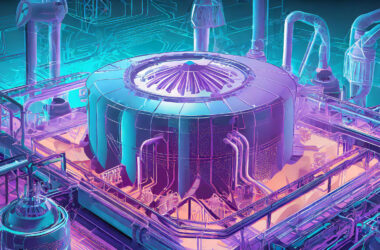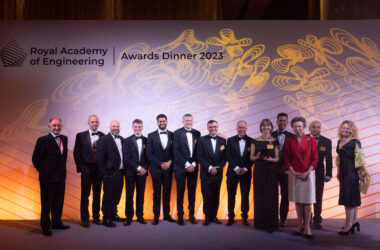In the ever-evolving landscape of energy production, a new contender has emerged, promising to revolutionize how we think about nuclear power: the Micro Modular Reactor (MMR).
An MMR is a compact, nuclear-based power source designed to provide energy with efficiency and minimal waste.

MMRs are not just smaller versions of their larger counterparts. They are meticulously designed to address some of the most pressing concerns associated with nuclear energy, such as safety and waste production. With the global push towards renewable energy sources, MMRs are poised to play a pivotal role in ensuring a seamless transition. Their compact design makes them ideal for remote areas, ensuring that even the most isolated communities can access reliable electricity.
The innovative design of MMRs results in significantly reduced waste production. To put it in perspective, a single MMR can power up to 5,000 people for two decades, producing only about a cubic meter of radioactive waste. This starkly contrasts conventional nuclear reactors, which generate considerably more waste.
The World’s First MMR: A Milestone in Nuclear Energy
At the end of 2022, a historic announcement from the Canadian Nuclear Laboratories (CNL) marked the dawn of a new era in nuclear energy. They confirmed the construction of the world’s first Micro Modular Reactor at their Chalk River site in Ontario. This groundbreaking initiative is set to be a game-changer, not just for Canada but for the global energy sector.
So, what makes this particular reactor design unique? This MMR is designed to replace 200 million litres of diesel fuel. Its compact design is tailored to provide energy to remote areas, ensuring that even the most distant communities are not left in the dark.
One of the standout features of this reactor is its assembly process. Envisioned as a “Lego-like” construction, the MMR will be built in 90 segments, each roughly the size of transport trucks. These segments will then be shipped to their designated locations for assembly. This modular approach simplifies the construction process and promises significant cost reductions in the long run. As production scales up, costs are expected to drop by approximately 20% with every doubling of the total output.
The Chalk River MMR is slated to be fully operational by 2027 and will be a demonstration site powering the CNL campus.
Latest MMR Project News
This week the Ultra Safe Nuclear Corporation UK (USNC) selected Jacobs, a Dallas-based engineering company, to play a pivotal role in developing the Micro Modular Reactor (MMR) project.
Jacobs is no stranger to the world of nuclear energy. The US company has a rich history of over 60 years in research, design, and operational support for high-temperature gas-cooled reactors; the company brings a wealth of knowledge.
One of the primary responsibilities entrusted to Jacobs is the front-end engineering design program for the MMR project. This encompasses everything from fro-refuelling analysis and refuelling systems to safety case and security considerations.
Karen Wiemelt, the Senior Vice President of Jacobs Energy, Security, and Technology, encapsulated the significance of the project, stating that the high-temperature reactor has the potential to usher nuclear power into a new era.
The Department for Energy Security and Net Zero financially backs the new MMR project. The financial backing will add up to $29 million and is earmarked for developing the MMR Energy System.
The Ultra Safe Nuclear Corporation UK (UNSC) has pledged to match this grant, effectively doubling the funds available for the project. This combined financial muscle is set to catalyze the second phase of work, with the ambitious goal of building a UK demonstrator of the high-temperature gas-cooled reactor by the early 2030s.
This financial support underscores the faith of key stakeholders in the project and provides the necessary resources to navigate the challenges of pioneering new technology. Every project phase will benefit from this financial infusion, from research and development to testing and deployment.
Features and Benefits of the MMR Energy System
The MMR Energy System, developed by Ultra Safe Nuclear, is not just another addition to the nuclear energy landscape; it’s a transformative solution designed to address some of our most pressing energy challenges. Let’s delve into the standout features and benefits of this innovative system.
- Harmony with Renewables: One of the most distinctive attributes of the MMR Energy System is its ability to integrate with renewable energy sources seamlessly. Think of it as a carbon-free natural gas power plant. It’s adept at adjusting to fluctuating demand, compensating for the intermittent power supply often associated with renewable sources like wind and solar. This ensures a consistent, uninterrupted power supply, even when renewables aren’t operating at peak capacity.
- Carbon Emission Reduction: The MMR Energy System is a champion of green energy. It operates without emitting carbon, making it a vital tool in the global fight against climate change. Utilizing MMR units in tandem with wind and solar assets makes it possible to meet 100% of energy demand without any carbon emissions.
- Versatility and Scalability: The design of the MMR Energy System is inherently versatile. Whether it’s an arctic environment or a tropical setting, the system requires no water, electrical grid, or infrastructure support to operate. Furthermore, its modular nature means that multiple MMR units can be linked, scaling the power output to meet the needs of communities, large industrial sites, or entire cities.
- Safety First: Safety is paramount in the realm of nuclear energy, and the MMR Energy System is no exception. The system employs encapsulated TRISO particle fuel and is cooled by helium, ensuring it operates without carbon emissions. Moreover, it adheres to the highest safety standards, aiming to serve as a safer alternative to gas plants that currently balance power grids.
- Broad Applications: The MMR Energy System has more general applications beyond just power generation. The UK demonstrator, for instance, will focus on producing high-temperature process heat for industrial applications. This versatility ensures that the system can cater to diverse energy needs.
The MMR Energy System is more than just a nuclear reactor; it’s a holistic solution designed to reshape the energy sector, making it more sustainable, efficient, and environmentally friendly.
The MMR project is not just about producing energy; it’s about doing so in a way that combats climate change. Operating without carbon emissions, the MMR is a powerful tool in the global effort to reduce greenhouse gases. Integrating MMRs with renewable energy sources makes achieving a carbon-neutral energy grid possible, paving the way for a cleaner, greener future. The project is a testament to the possibilities that arise when innovation meets responsibility. By prioritizing safety and environmental stewardship, the project promises not just to power our homes and industries but to do so in a way that safeguards our planet and its inhabitants.
TLDR
- Micro Modular Reactors (MMRs) are compact nuclear power sources designed for efficiency and minimal waste.
- The world’s first MMR is under construction in Chalk River, Canada, aiming replace 200 million litres of diesel fuel.
- Jacobs, a renowned engineering company, plays a pivotal role in the MMR project, handling design, licensing, and system integration.
- The UK Department for Energy Security and Net Zero has granted significant financial support, matched by the Ultra Safe Nuclear Corporation UK.
- MMRs offer seamless integration with renewables, carbon emission reduction, versatility, and enhanced safety features.
- Prioritizing safety and environmental stewardship, MMRs produce minimal waste and have a reduced land footprint.
- The global impact of MMRs includes addressing energy inequity, fostering innovation, and driving a sustainable energy revolution.







